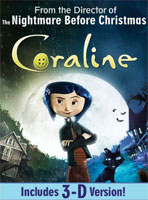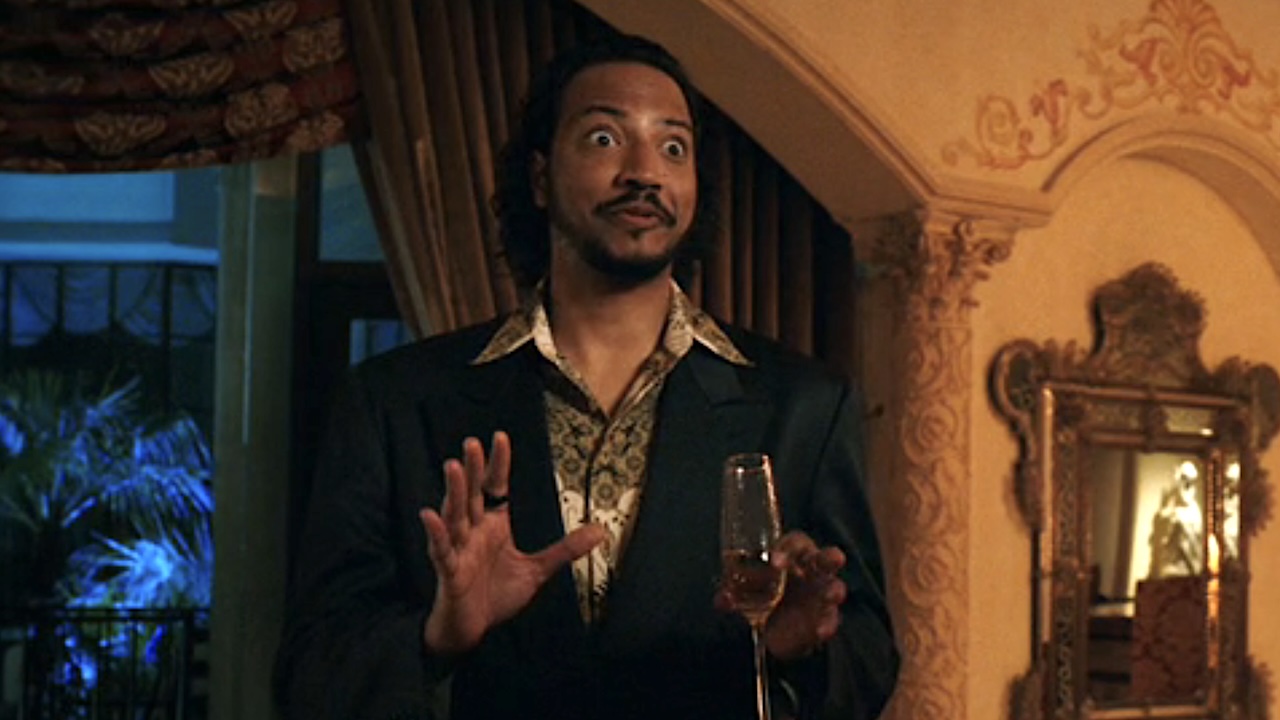Nobody enjoys going to the eye doctor, especially a kid. Coraline is a horror movie in disguise. It pulls children in with vibrant colors and entrancing animation like a mother bribing her son or daughter to take some medicine as long as she provides an ice cream chaser. Once you’re at the point of no return, the poking and prodding begins. Funny thing is, the ‘other’ mother in Coraline uses the same tactic. Director Henry Selick kicks the stellar stop-motion animation into full gear the moment the movie begins. While you’re mesmerized by the ability to create such intricate and realistic images using inanimate objects, the child next to you is likely to be in terror watching a ragdoll be torn apart using implements frequently found in the torture chambers in Saw and Hostel. At least there’s a friendly young blue-haired girl to greet you after the opening credits. Coraline Jones (Dakota Fanning) has just moved into the Pink Palace Apartments with her parents. Her parents may love her, but they don’t have much free time to dote on her, let alone cook her a tasty meal. That neglect may be the reason Coraline doesn’t emulate the typical female protagonist you find in animated films. She’s brash, loud and borderline annoying. It takes time to warm up to her.
Her sour attitude doesn’t keep the neighbors away. A young boy with a stray black cat as a pet, Wybie Lovat (Robert Bailey Jr.), takes an early liking to Coraline and a team of retired actresses, Misses Spink (Jennifer Saunders) and Forcible (Dawn French), even share their talents with her. There’s also Mr. Bobinsky (Ian McShane), an acrobat training a group of mice to perform in a circus show.
The eccentricity of those around her isn’t enough to keep her entertained so one night Coraline opens a small door in her home that she believes leads to another world. After crawling through a tunnel of aura she reaches the other side to find she’s right back where she started. Disappointed, she heads back for her bedroom, but stops in her tracks when she notices an unusual but glorious smell, the smell of good food. Upon entering the kitchen, she’s shocked to find her mother’s eyes have been replaced by black buttons. After explaining that this new feature is because she’s Coraline’s ‘other’ mother (Teri Hatcher), Coraline plops down at the dinner table to indulge in the meal of every kid’s dreams. After dinner Coraline is brought upstairs to her room, which has magically transformed into a warm abode packed with lively toys. Her ‘other’ parents tuck her in and she falls asleep.
Coraline awakes the next morning to suffer another blow of a disappointment. She’s back in her original dreary home. She tries to explain to her real mother what she’d experienced the night before, but she dismisses her story as nonsense. Coraline continues visiting Other World at night and indulging in all of its wonders while the audience gets a similar experience going from the dull real world to the vibrancy of this alternate universe.
The film’s only downfall is that it’s trying to appeal to two demographics at once. Much of the dialogue and the entire plot for that matter, is geared toward children. There’s a fabulous new world filled with strange creatures and even the opportunity to get what every child wishes for when mom and dad say no; new parents who understand. Before these children have the chance to cover their eyes they’re bombarded with terrible images like the eating of a live bug, seeing an innocent mouse being torn apart and a poor boy with a smile stapled on his face. Worst of all is the concept of having to replace your eyes with buttons. Kids kick and scream before having an optometrist dilate their pupils, and you think they’ll be able to bear this idea?
Visually, Coraline is a stunning film. In terms of the other elements, it can teeter either way. To really appreciate the plot you’ll need to push your inhibitions and expectations aside and take it for what it is, a story for children. When it comes to kids, I suggest administering The Nightmare Before Christmas test before allowing your child to see this film. If they survive that film without developing an intense fear of the boogeyman or Santa Claus, you can give Coraline the green light. The bonus feature menu is lonelier than Coraline at the beginning of the film. You’d expect a film with such a detailed production process to have loads of extra material to sort into small featurettes, but the only special feature you’ll have access to is commentary with director Henry Selick and composer Bruno Coulais. Selick has tons of interesting information about Coraline to relay, but his oration quickly becomes monotonous. Selick himself even seems bored with his speech. It’s too bad the commentary didn’t include Dakota Fanning and Teri Hatcher. Perhaps their perspectives may have lightened the tone and made the material seem less like a boring history lecture and more like an enjoyable reminiscence. No, I didn’t forget about Coulais, but I get the feeling Selick almost had. Coulais doesn’t chime in until the end credits and only gets a mere four minutes to chat music with the audience.
After suffering through an entire childhood enjoying the glories of the third dimension wearing those goofy paper glasses, I was shocked to see how much the technology had progressed since I saw my first 3D feature length film. Not only have the glasses been upgraded to plastic, but the quality is outstanding. Within minutes you’ll forget you’re even wearing the glasses and be completely immersed in the film. Sadly, the advancement does not translate to a home theater. Watching Coraline in 3D with the old school glasses that came with the film is taking a giant step backwards. It’s more like looking through a kaleidoscope than looking through glasses meant to add another dimension to the image. What sets Coraline apart from other animated films, is the genuine beauty of the image. CGI animation is spectacular but stop-motion animations create a much more realistic pictures; almost as if you can reach out and grab it. Technology can work wonders on the big screen, but if used and abused it can completely tarnish material that may have been beautiful in its original form. Don’t spoil Coraline by flipping the disc over to the 3D side.
Your Daily Blend of Entertainment News
Lastly, from a financial perspective, I understand why Blu-rays are loaded with special features and DVDs, in comparison, are lacking. But in Coraline’s case, I feel like I’m being punished for getting the DVD version. I’m not asking for interactive features like U-Control and BD Live; all I want is a few production featurettes. When the BD version comes with such a significant amount of bonus material and the DVD version only has some mediocre commentary, how can you not feel cheated?
Staff Writer for CinemaBlend.


